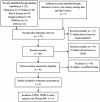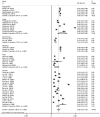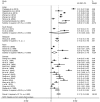Prevalence of diabetic retinopathy, proliferative diabetic retinopathy and non-proliferative diabetic retinopathy in Asian T2DM patients: a systematic review and Meta-analysis
- PMID: 30809489
- PMCID: PMC6376231
- DOI: 10.18240/ijo.2019.02.19
Prevalence of diabetic retinopathy, proliferative diabetic retinopathy and non-proliferative diabetic retinopathy in Asian T2DM patients: a systematic review and Meta-analysis
Abstract
Aim: To investigate the pooled prevalence of diabetic retinopathy (DR), proliferative DR (PDR) and nonproliferative DR (NPDR) in Asian type 2 diabetes mellitus (T2DM) patients.
Methods: We performed a systematic search online search using PubMed, EMBASE, Web of Science, the Cochrane Library, and China WeiPu Library to identify eligible studies that reported the prevalence of DR, PDR and NPDR in Asian T2DM patients. Effect size (ES) with 95% confidence interval (CI) was used to evaluate the prevalence of DR, PDR and NPDR in Asian T2DM patients, respectively.
Results: There were 41 references and 48 995 T2DM patients involved in this study. The prevalence of DR, PDR, and NPDR was 28%, 6%, and 27% in T2DM patients, respectively; while the prevalence of PDR and NPDR in DR patients was 17% and 83%, respectively. Subgroup analysis showed that prevalence of DR in T2DM patients from Singaporean, Indian, South Korean, Malaysian, Asian, and Chinese was 33%, 42%, 16%, 35%, 21% and 25%, respectively. In T2DM patients with NPDR from Indian, South Korean, Malaysian, Asian, Chinese, higher prevalence was found than that in PDR patients (45% vs 17%, 13% vs 3%, 30% vs 5%, 23% vs 2% and 22% vs 3%), as well as in DR patients (74% vs 26%, 81% vs 19%, 86% vs 14%, 92% vs 8% and 85% vs 15%). The prevalence of PDR in T2DM from India was higher than patients from other locations of Asia, and the same results were also observed in NPDR patients.
Conclusion: In either T2DM Asian patients or DR patients, NPDR is more common than PDR. Based on our results, we should pay more attention to NPDR screening and management in T2DM patients, and we also recommend suitable interventions to prevent its progression.
Keywords: Asian; nonproliferative diabetic retinopathy; prevalence; proliferative diabetic retinopathy; type 2 diabetes mellitus.
Figures
Similar articles
-
Serum Untargeted Metabolomics Reveal Potential Biomarkers of Progression of Diabetic Retinopathy in Asians.Front Mol Biosci. 2022 Jun 9;9:871291. doi: 10.3389/fmolb.2022.871291. eCollection 2022. Front Mol Biosci. 2022. PMID: 35755823 Free PMC article.
-
[Association of choroidal thickness with diabetic retinopathy at different stages].Zhonghua Yi Xue Za Zhi. 2015 Aug 25;95(32):2584-8. Zhonghua Yi Xue Za Zhi. 2015. PMID: 26711604 Chinese.
-
Association between cystatin C and diabetic retinopathy among type 2 diabetic patients in China: a Meta-analysis.Int J Ophthalmol. 2021 Sep 18;14(9):1430-1440. doi: 10.18240/ijo.2021.09.21. eCollection 2021. Int J Ophthalmol. 2021. PMID: 34540622 Free PMC article.
-
Associations between Vascular Endothelial Growth Factor Gene Polymorphisms and Different Types of Diabetic Retinopathy Susceptibility: A Systematic Review and Meta-Analysis.J Diabetes Res. 2021 Jan 4;2021:7059139. doi: 10.1155/2021/7059139. eCollection 2021. J Diabetes Res. 2021. PMID: 33490285 Free PMC article.
-
Creatinine as a predictor of proliferative diabetic retinopathy among patients with type 2 diabetes mellitus: a systematic review and meta-analysis.Int Urol Nephrol. 2025 Jun 3. doi: 10.1007/s11255-025-04590-3. Online ahead of print. Int Urol Nephrol. 2025. PMID: 40461778 Review.
Cited by
-
Diabetic retinopathy as the leading cause of blindness and early predictor of cascading complications-risks and mitigation.EPMA J. 2023 Feb 13;14(1):21-42. doi: 10.1007/s13167-023-00314-8. eCollection 2023 Mar. EPMA J. 2023. PMID: 36866156 Free PMC article. Review.
-
Changes in serum lipids with the onset and progression of Diabetic Retinopathy in Type-II Diabetes Mellitus.Pak J Med Sci. 2023 Jan-Feb;39(1):188-191. doi: 10.12669/pjms.39.1.6265. Pak J Med Sci. 2023. PMID: 36694747 Free PMC article.
-
Serum Untargeted Metabolomics Reveal Potential Biomarkers of Progression of Diabetic Retinopathy in Asians.Front Mol Biosci. 2022 Jun 9;9:871291. doi: 10.3389/fmolb.2022.871291. eCollection 2022. Front Mol Biosci. 2022. PMID: 35755823 Free PMC article.
-
The study of eye care behaviors in patients with type 2 diabetes.J Diabetes Metab Disord. 2020 Feb 4;19(1):257-263. doi: 10.1007/s40200-020-00499-z. eCollection 2020 Jun. J Diabetes Metab Disord. 2020. PMID: 32550174 Free PMC article.
-
Supplementation with a Highly Concentrated Docosahexaenoic Acid (DHA) in Non-Proliferative Diabetic Retinopathy: A 2-Year Randomized Double-Blind Placebo-Controlled Study.Antioxidants (Basel). 2022 Jan 5;11(1):116. doi: 10.3390/antiox11010116. Antioxidants (Basel). 2022. PMID: 35052620 Free PMC article.
References
-
- Hod M, Kapur A, Sacks DA, Hadar E, Agarwal M, di Renzo GC, Roura LC, McIntyre HD, Morris JL, Divakar H. The International Federation of Gynecology and Obstetrics (FIGO) Initiative on gestational diabetes mellitus: a pragmatic guide for diagnosis, management, and care. Int J Gynaecol Obstet. 2015;131:S173–S211. - PubMed
-
- Vinik AI, Nevoret ML, Casellini C, Parson H. Diabetic neuropathy. Endocrinol Metab Clin North Am. 2013;42(4):747–787. - PubMed
-
- Yamagishi S, Imaizumi T. Diabetic vascular complications: pathophysiology, biochemical basis and potential therapeutic strategy. Curr Pharm Des. 2005;11(18):2279–2299. - PubMed
LinkOut - more resources
Full Text Sources



